The face of Russian software. Or some statistics from the Unified Register of Russian computer programs and databases
Many of those who work with government customers or directly in government agencies have probably come across a Unified Register of Russian software for electronic computers and databases . The registry was created on the basis of the broadly-known Decree of the Government of the Russian Federation dated 11.16.2015 “On the prohibition of admission of software originating from foreign states for the purpose of procurement to meet state and municipal needs” .
You can debate for a long time whether the Registry positively or negatively affects the development of domestic software, but all government agencies are obliged to use only the software included in the Registry, or justify the impossibility of complying with the ban on the admission of foreign software. Surely the purchase of Windows, Microsoft offices and other Oracle and Aybim will continue for a very, very long time. However, Russian operating systems such as Alt Linux, Astra Linux or OS Rosa are slowly emerging, sprouts of office suites , domestic blockchains are breaking through. There are Russian DBMSs from well-known ClickHouse or Linter to completely unknown developments. And of course, there can be no domestic Java . In order to remove possible questions or disputes, I will make a reservation that the above software is named Russian in the article on the basis of its inclusion in the Register, everyone can conduct a more detailed study of this issue themselves.
So, the Registry has been operating for almost 4 years and, according to paragraph 37 of the Procedure for maintaining it, the information stored in it is open and public. Well, if this information is open and public, then why not analyze it?
The article provides some statistics on the Unified Register of Russian software for electronic computers and databases. If it became interesting to you, I ask under cat.
The registry is formed on the basis of the decisions of the Expert Council for Russian software . The Expert Council receives applications from copyright holders, the council considers these applications in accordance with administrative regulations and votes to include or not include software in the Register. Everything seems to be simple.
As of October 4, 2019 (all the data in the article are current on this date), 5819 programs are included in the Register, while 7143 applications were submitted, and 61 programs were excluded from the Register. All software in the Registry is divided into 27 classes:
The Register includes programs belonging to 1998 legal entities and 192 individuals. The software copyright holders from the Register are registered in 70 regions of the Russian Federation, while I note that for 2019 for 71 software products and 60 copyright holders it was not possible to establish the place of registration of the copyright holder on the basis of open data. The reason is simple: data on legal entities and individual entrepreneurs is publicly available, for individuals to make such data publicly available.
Let's see how the Register has been updated by years.
The table shows the number of applications submitted (based on the filing date) included in the Program Register (based on the date of the decision to include), refusals to include (based on the date of publication of the order of the Ministry of Communications), exceptions from the Register (based on the date of publication of the order of the Ministry of Communications) .

Let's look at the statements and decisions on inclusion by quarters:
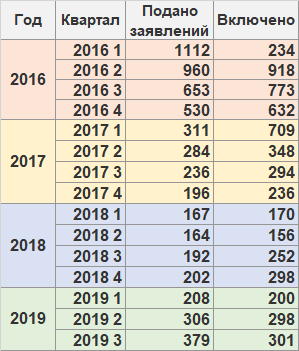
And in the same section, we construct a graph where blue indicates the inclusion in the Register, and orange submission of applications:

Obviously, the peak of application submission occurred in 2016, i.e., at the time of the creation of the Register, since inclusion takes time, the peak of inclusion in the Register fell already in the 2nd quarter of 2016. In 2019, there has been a slight increase in the number of applications and stabilization of inclusion in the Register (329 refusals in inclusion were issued for the year not yet ended, while in 2017 and 2018 there were 238 and 218 refusals).
To date, 5900 applications in the following statuses have been submitted to the Register.

I note that applications for which refusals are made are not available through the Registry website. However, information on them can be found in the orders of the Ministry of Communications and Minutes of the meeting of the Expert Council. By the way, the number of software in the Registry and the number of applications with the status “Included in the registry” do not converge. There are probably some reasons for this.
Let's look at the reasons for exclusion from the Registry:

As you can see, most of the exceptions are initiated by the copyright holders.
And here are the reasons for power failure:

Surely every refusal or exception has its own little drama, but we will not know.
Since there are data on copyright holders in the Register, it will be extremely interesting to find out in what regions of our country and how many developers of Russian software live in. But if the question is formulated more correctly, then I proceed from the regions in which the copyright holders of the software included in the Register are registered.
First, I’ll give you a map showing how many programs are currently registered in the Registry in the region.
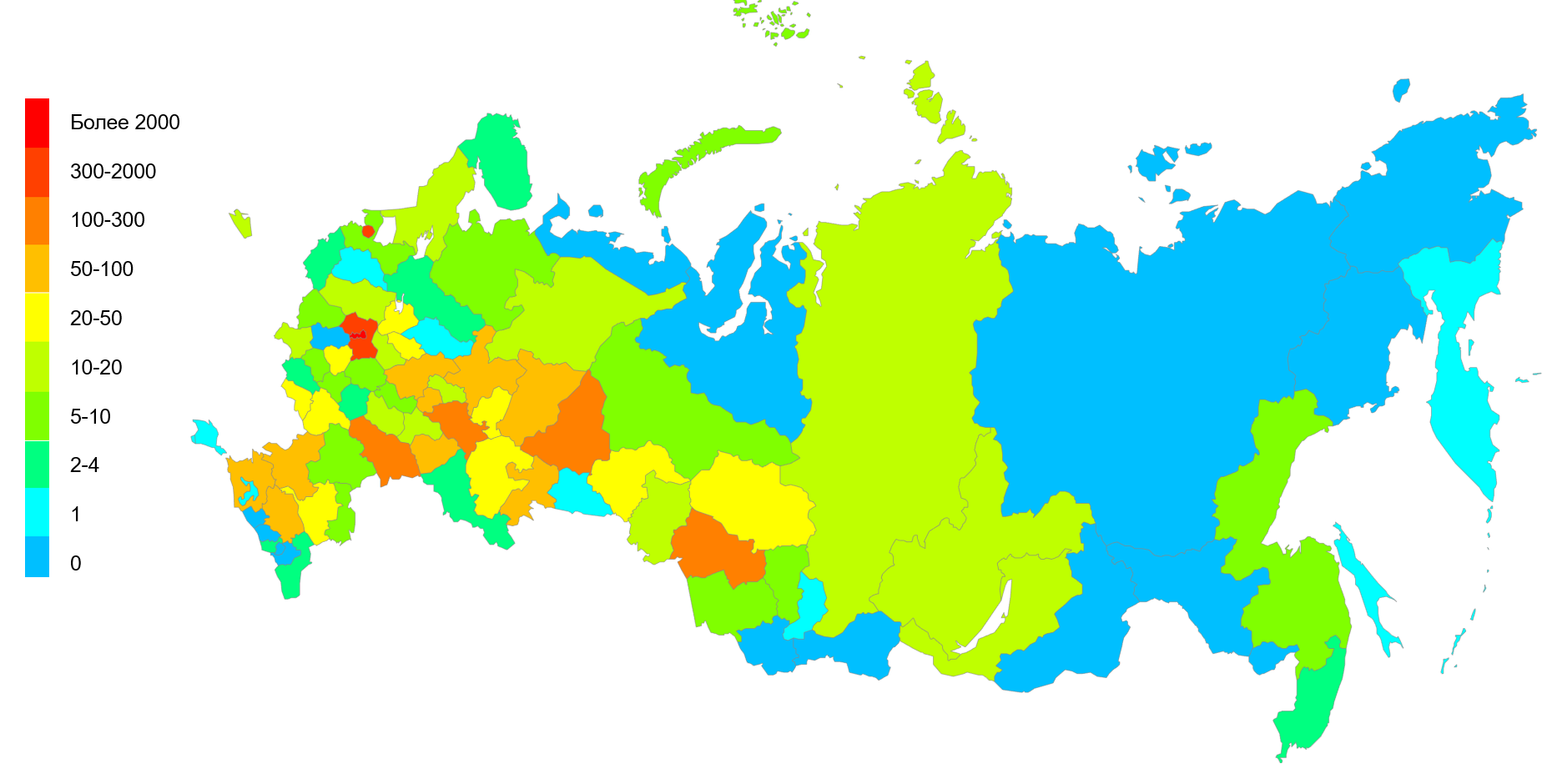
The card clearly hints that almost half of Russian software is registered by copyright holders from Moscow. Following are St. Petersburg and the Moscow region. I note that the programs registered in the Register are being counted, and not the copyright holders themselves. You can see in more detail in the plate, which displays the number of registered programs at the end of each year. Sorted by the number of registrations for 2019.

There is nothing surprising in the table. Perhaps, the rapid breakthrough in the Saratov region, which overtook such high-profile regions as Tatarstan and the Novosibirsk Region in 2019 by the number of programs registered in the Register, is a little surprising. About the reasons for this jerk a little later. In addition, I cannot but rejoice that the share of developments from Moscow this year finally fell below 50%. This says that IT in the regions is alive (well, at least a little). The lower part of the table also hints that at least some developments are in the regions.
To make the dynamics more visible, let's look at a graph showing the number of registered programs for the first 16 regions by year:

Yes, not very clearly. We remove Moscow, St. Petersburg and the Moscow region from the schedule.
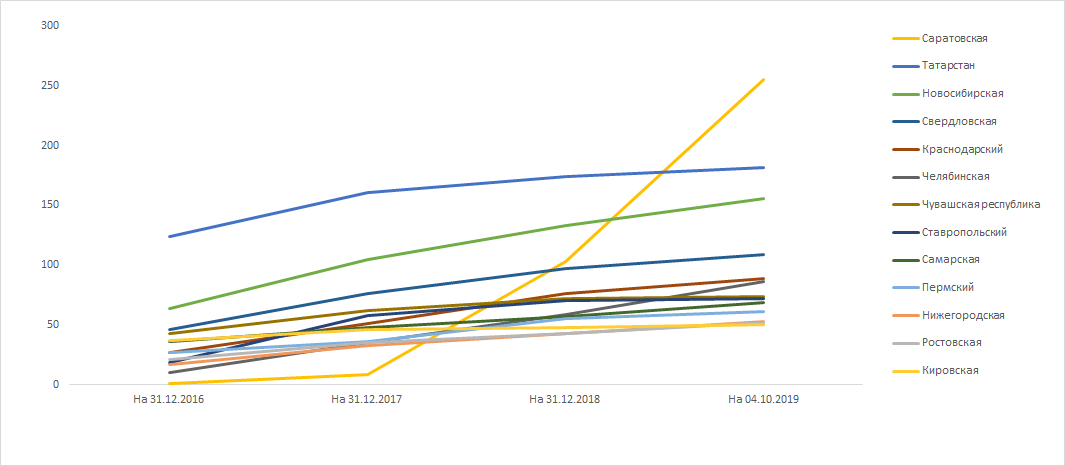
It did not become much clearer. However, a surge in the Saratov region and the stable position of Tatarstan, the Novosibirsk and Sverdlovsk regions were even more clearly seen.
I will also give the distribution of copyright holders by region:

For those who are interested in the distribution of registrations in the Register by city, the information is given in the spoiler:
As mentioned above, the software classes are defined in the Registry. Let's see how the software is distributed among these classes:
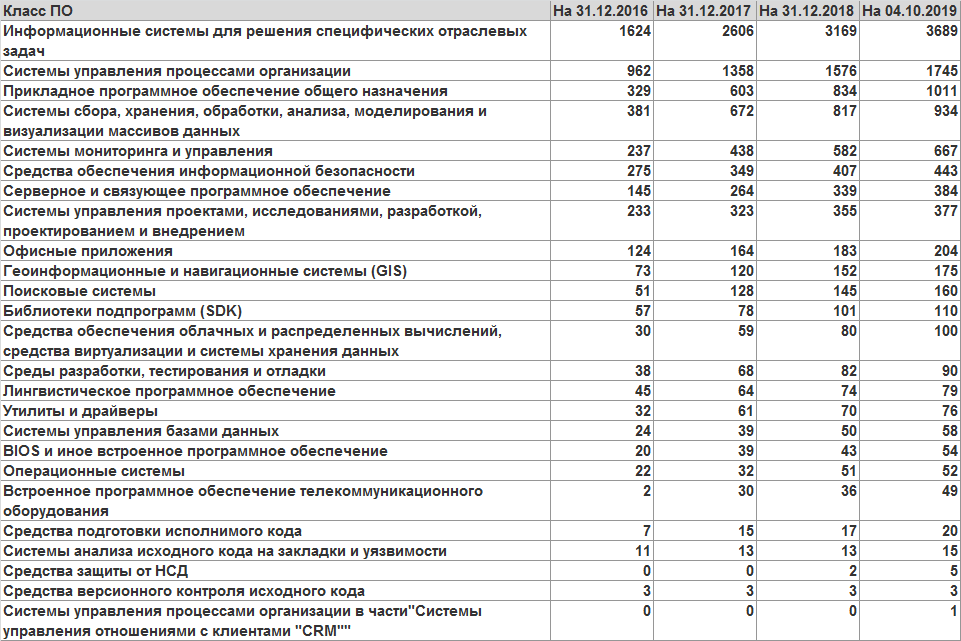
Most of the information systems account for specific tasks, followed by process control systems and general-purpose application software.
But not a little in the DBMS Registry, OS and other serious things, there is even one CRM ...
Finally, some statistics about the copyright holders whose software is in the Register. The table below shows the groups of copyright holders by the number of registrations. For example, it can be seen from it that in 2019, 11 copyright holders had more than 50 products registered in the Register, and 1263 only one product each.

There are not so many mass manufacturers of Russian software, only thirty copyright holders have registered more than 20 programs.
Let's take a closer look at this thirty:
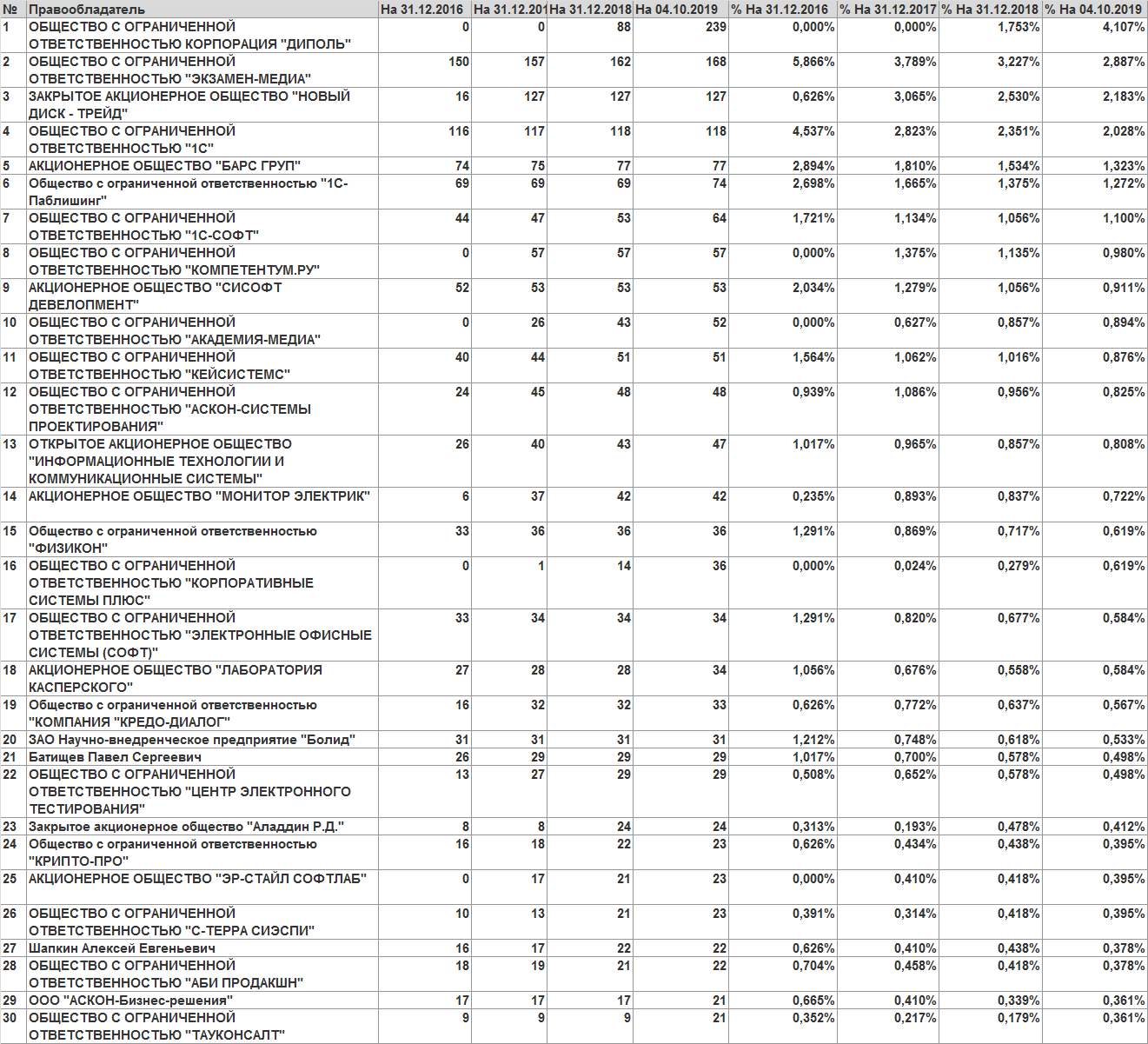
And ...OracleGoogleMicrosoftIBM Dipole Corporation leads the list of the most fruitful copyright holders. The portfolio of their programs consists of electronic methodological complexes from Physics and Russian Language and literature to the Welder and Tailor complexes. Revealing the intrigue of the section on regions, I will say that the Dipole Corporation is registered in the Saratov region. From there, and growth in the division of regions.
It is impossible not to notice that in 4.6 and 7 places there are 1C products in various forms. Well, this is quite logical.
In the list above, I met quite a lot of familiar names: “Bars Group”, “Ascon”, “Kaspersky Lab”, “Aladdin R.D.”, “Crypto-PRO”, “R-Style” and “S-TERRA”. However, individuals located at 21 and 27 places are surprised. Their productivity can only be envied.
Let's see, what do copyright holders do? To do this, group them according to the main OKVED:

No surprises. For the most part, copyright holders are involved in software development. Many research organizations and consultants.
There will be no conclusions. Yes, and they are hardly possible in this case. At least I, and the one who read the article to this place, began to know a little more about that same Russian software.
You can debate for a long time whether the Registry positively or negatively affects the development of domestic software, but all government agencies are obliged to use only the software included in the Registry, or justify the impossibility of complying with the ban on the admission of foreign software. Surely the purchase of Windows, Microsoft offices and other Oracle and Aybim will continue for a very, very long time. However, Russian operating systems such as Alt Linux, Astra Linux or OS Rosa are slowly emerging, sprouts of office suites , domestic blockchains are breaking through. There are Russian DBMSs from well-known ClickHouse or Linter to completely unknown developments. And of course, there can be no domestic Java . In order to remove possible questions or disputes, I will make a reservation that the above software is named Russian in the article on the basis of its inclusion in the Register, everyone can conduct a more detailed study of this issue themselves.
So, the Registry has been operating for almost 4 years and, according to paragraph 37 of the Procedure for maintaining it, the information stored in it is open and public. Well, if this information is open and public, then why not analyze it?
The article provides some statistics on the Unified Register of Russian software for electronic computers and databases. If it became interesting to you, I ask under cat.
General information
The registry is formed on the basis of the decisions of the Expert Council for Russian software . The Expert Council receives applications from copyright holders, the council considers these applications in accordance with administrative regulations and votes to include or not include software in the Register. Everything seems to be simple.
As of October 4, 2019 (all the data in the article are current on this date), 5819 programs are included in the Register, while 7143 applications were submitted, and 61 programs were excluded from the Register. All software in the Registry is divided into 27 classes:
Software Classes in the Registry
- BIOS and other firmware
- database (invalid)
- Telecommunication Equipment Embedded Software
- Geographic Information and Navigation Systems (GIS)
- Specialized software for executive authorities of the Russian Federation, state corporations, companies and legal entities with the predominant participation of the Russian Federation for internal use
- NSD protection
- Operating Systems
- Utilities and Drivers
- Cloud and Distributed Computing, Virtualization, and Storage
- Server and middleware
- Database management systems
- Monitoring and control systems
- Information Security Tools
- Executable Code Preparation Tools
- Source Version Controls
- Subroutine Libraries (SDKs)
- Development, Testing, and Debugging Environments
- Bookmarking and Vulnerability Source Code Analysis Systems
- General-Purpose Application Software
- Office applications
- Search engines
- Linguistic software
- Project management systems, research, development, design and implementation
- Organization Process Management Systems
- Organization process management systems in the part “CRM Customer Relationship Management Systems”
- Systems for the collection, storage, processing, analysis, modeling and visualization of data arrays
- Information systems for solving specific industry problems
The Register includes programs belonging to 1998 legal entities and 192 individuals. The software copyright holders from the Register are registered in 70 regions of the Russian Federation, while I note that for 2019 for 71 software products and 60 copyright holders it was not possible to establish the place of registration of the copyright holder on the basis of open data. The reason is simple: data on legal entities and individual entrepreneurs is publicly available, for individuals to make such data publicly available.
Historical information
Let's see how the Register has been updated by years.
The table shows the number of applications submitted (based on the filing date) included in the Program Register (based on the date of the decision to include), refusals to include (based on the date of publication of the order of the Ministry of Communications), exceptions from the Register (based on the date of publication of the order of the Ministry of Communications) .

Let's look at the statements and decisions on inclusion by quarters:

And in the same section, we construct a graph where blue indicates the inclusion in the Register, and orange submission of applications:

Obviously, the peak of application submission occurred in 2016, i.e., at the time of the creation of the Register, since inclusion takes time, the peak of inclusion in the Register fell already in the 2nd quarter of 2016. In 2019, there has been a slight increase in the number of applications and stabilization of inclusion in the Register (329 refusals in inclusion were issued for the year not yet ended, while in 2017 and 2018 there were 238 and 218 refusals).
To date, 5900 applications in the following statuses have been submitted to the Register.

I note that applications for which refusals are made are not available through the Registry website. However, information on them can be found in the orders of the Ministry of Communications and Minutes of the meeting of the Expert Council. By the way, the number of software in the Registry and the number of applications with the status “Included in the registry” do not converge. There are probably some reasons for this.
Let's look at the reasons for exclusion from the Registry:

As you can see, most of the exceptions are initiated by the copyright holders.
And here are the reasons for power failure:

Surely every refusal or exception has its own little drama, but we will not know.
Regions
Since there are data on copyright holders in the Register, it will be extremely interesting to find out in what regions of our country and how many developers of Russian software live in. But if the question is formulated more correctly, then I proceed from the regions in which the copyright holders of the software included in the Register are registered.
First, I’ll give you a map showing how many programs are currently registered in the Registry in the region.

The card clearly hints that almost half of Russian software is registered by copyright holders from Moscow. Following are St. Petersburg and the Moscow region. I note that the programs registered in the Register are being counted, and not the copyright holders themselves. You can see in more detail in the plate, which displays the number of registered programs at the end of each year. Sorted by the number of registrations for 2019.

There is nothing surprising in the table. Perhaps, the rapid breakthrough in the Saratov region, which overtook such high-profile regions as Tatarstan and the Novosibirsk Region in 2019 by the number of programs registered in the Register, is a little surprising. About the reasons for this jerk a little later. In addition, I cannot but rejoice that the share of developments from Moscow this year finally fell below 50%. This says that IT in the regions is alive (well, at least a little). The lower part of the table also hints that at least some developments are in the regions.
To make the dynamics more visible, let's look at a graph showing the number of registered programs for the first 16 regions by year:

Yes, not very clearly. We remove Moscow, St. Petersburg and the Moscow region from the schedule.

It did not become much clearer. However, a surge in the Saratov region and the stable position of Tatarstan, the Novosibirsk and Sverdlovsk regions were even more clearly seen.
I will also give the distribution of copyright holders by region:

For those who are interested in the distribution of registrations in the Register by city, the information is given in the spoiler:
City distribution
Preventing the question of why the numbers do not converge, I will say that in 109 cases the city was unknown. Well, open data is imperfect.
1 Moscow 2 774
2 St. Petersburg 577
3 Saratov 254
4 Kazan 149
5 Novosibirsk 131
6 Dolgoprudny 120
7 Yekaterinburg 104
8 Cheboksary 73
9 Krasnodar 71
10 Zelenograd 62
11 Perm 59
12 Samara 57
13 Kirov 50
14 Tomsk 48
15 Queens 47
16 Nizhny Novgorod 43
17 Pyatigorsk 42
18 Belgorod 40
19 Magnitogorsk 38
20 Kolomna 34
21 Rostov-on-Don 32
22 Kaluga 29
23 Voronezh 29
24 Stavropol 29
25 Tyumen 29
26 Miass 27
27 Innopolis 25
28 Ivanovo 24
29 Krasnogorsk 24
30 Ufa 24
31 Yaroslavl 22
32 Tula 22
33 Izhevsk 21
34 Dubna 20
35 Krasnoyarsk 19
36 Chelyabinsk 19
37 Berdsk 19
38 Yoshkar-Ola 17
39 Kaliningrad 17
40 Solnechnogorsk 15
41 Penza 15
42 Ukhta 14
43 Tver 14
44 Noginsk 14
45 Bryansk 13
46 Petrozavodsk 13
47 Irkutsk 13
48 Tolyatti 12
49 Ulyanovsk 12
50 Ulan-Ude 11
51 Omsk 11
52 Chernogolovka 10
53 Pushkin 9
54 Eagle 9
55 Sergiev Posad 9
56 Smolensk 9
57 Ryazan 9
58 Vladimir 8
59 Elektrostal 8
60 Khabarovsk 8
61 Obninsk 8
62 Sarov 8
63 Mytishchi 8
64 Saransk 7
65 Khimki 7
66 Azov 7
67 Egorievsk 7
68 Rybinsk 6
69 Taganrog 6
70 Astrakhan 6
71 Barnaul 6
72 Lytkarino 5
73 Beloretsk 5
74 Lipetsk 5
75 Troitsk 5
76 Volgograd 5
77 Korenovsk 5
78 Vladivostok 4
79 Naberezhnye Chelny 4
80 Odintsovo 4
81 Neftekamsk 4
82 Podolsk 4
83 Arkhangelsk 4
84 Kemerovo 4
85 Khanty-Mansiysk 4
86 Novocherkassk 3
87 Surgut 3
88 Volzhsky 3
89 Pavlovsk 3
90 Balashikha 3
91 Armavir 3
92 Syktyvkar 3
93 Zhukovka 3
94 Pskov 3
95 Fryazino 3
96 Sterlitamak 2
97 Lyubertsy 2
98 Novokuznetsk 2
99 Labinsk 2
100 Krasnoturinsk 2
101 Nizhnevartovsk 2
102 Lysva 2
103 Krasnoarmeysk 2
104 Prominent 2
105 Chistopol 2
106 Sochi 2
107 Serpukhov 2
108 Tambov 2
109 Kursk 2
110 Orenburg 2
111 Zarechny 2
112 Kaspiysk 2
113 Kolpino 2
114 Nizhny Tagil 2
115 Vladikavkaz 2
116 Mines 2
117 Novorossiysk 2
118 Vologda 2
119 Severodvinsk 1
120 Protvino 1
121 Naro-Fominsk 1
122 Murmansk 1
123 Dimitrovgrad 1
124 Konakovo 1
125 Petropavlovsk-Kamchatsky 1
126 Barrow 1
127 eyes 1
128 Abakan 1
129 Essentuki 1
130 Tarusa 1
131 Volgodonsk 1
132 Sevastopol 1
133 Hot Key 1
134 Pushchino 1
135 Malakhovka 1
136 Kingisepp 1
137 Murom 1
138 Moscow 1
139 Apatity 1
140 Zhukovsky 1
141 Yuzhno-Sakhalinsk 1
142 Dzerzhinsk 1
143 Onions 1
144 Kstovo 1
145 Bratsk 1
146 Snezhinsk 1
147 Communard 1
148 Carpets 1
149 Ramenskoye 1
150 Schelkovo 1
151 Kurchatov 1
152 Votkinsk 1
153 Kostroma 1
154 Kropotkin 1
155 Novoaltaysk 1
156 Simferopol 1
157 Veliky Novgorod 1
1 Moscow 2 774
2 St. Petersburg 577
3 Saratov 254
4 Kazan 149
5 Novosibirsk 131
6 Dolgoprudny 120
7 Yekaterinburg 104
8 Cheboksary 73
9 Krasnodar 71
10 Zelenograd 62
11 Perm 59
12 Samara 57
13 Kirov 50
14 Tomsk 48
15 Queens 47
16 Nizhny Novgorod 43
17 Pyatigorsk 42
18 Belgorod 40
19 Magnitogorsk 38
20 Kolomna 34
21 Rostov-on-Don 32
22 Kaluga 29
23 Voronezh 29
24 Stavropol 29
25 Tyumen 29
26 Miass 27
27 Innopolis 25
28 Ivanovo 24
29 Krasnogorsk 24
30 Ufa 24
31 Yaroslavl 22
32 Tula 22
33 Izhevsk 21
34 Dubna 20
35 Krasnoyarsk 19
36 Chelyabinsk 19
37 Berdsk 19
38 Yoshkar-Ola 17
39 Kaliningrad 17
40 Solnechnogorsk 15
41 Penza 15
42 Ukhta 14
43 Tver 14
44 Noginsk 14
45 Bryansk 13
46 Petrozavodsk 13
47 Irkutsk 13
48 Tolyatti 12
49 Ulyanovsk 12
50 Ulan-Ude 11
51 Omsk 11
52 Chernogolovka 10
53 Pushkin 9
54 Eagle 9
55 Sergiev Posad 9
56 Smolensk 9
57 Ryazan 9
58 Vladimir 8
59 Elektrostal 8
60 Khabarovsk 8
61 Obninsk 8
62 Sarov 8
63 Mytishchi 8
64 Saransk 7
65 Khimki 7
66 Azov 7
67 Egorievsk 7
68 Rybinsk 6
69 Taganrog 6
70 Astrakhan 6
71 Barnaul 6
72 Lytkarino 5
73 Beloretsk 5
74 Lipetsk 5
75 Troitsk 5
76 Volgograd 5
77 Korenovsk 5
78 Vladivostok 4
79 Naberezhnye Chelny 4
80 Odintsovo 4
81 Neftekamsk 4
82 Podolsk 4
83 Arkhangelsk 4
84 Kemerovo 4
85 Khanty-Mansiysk 4
86 Novocherkassk 3
87 Surgut 3
88 Volzhsky 3
89 Pavlovsk 3
90 Balashikha 3
91 Armavir 3
92 Syktyvkar 3
93 Zhukovka 3
94 Pskov 3
95 Fryazino 3
96 Sterlitamak 2
97 Lyubertsy 2
98 Novokuznetsk 2
99 Labinsk 2
100 Krasnoturinsk 2
101 Nizhnevartovsk 2
102 Lysva 2
103 Krasnoarmeysk 2
104 Prominent 2
105 Chistopol 2
106 Sochi 2
107 Serpukhov 2
108 Tambov 2
109 Kursk 2
110 Orenburg 2
111 Zarechny 2
112 Kaspiysk 2
113 Kolpino 2
114 Nizhny Tagil 2
115 Vladikavkaz 2
116 Mines 2
117 Novorossiysk 2
118 Vologda 2
119 Severodvinsk 1
120 Protvino 1
121 Naro-Fominsk 1
122 Murmansk 1
123 Dimitrovgrad 1
124 Konakovo 1
125 Petropavlovsk-Kamchatsky 1
126 Barrow 1
127 eyes 1
128 Abakan 1
129 Essentuki 1
130 Tarusa 1
131 Volgodonsk 1
132 Sevastopol 1
133 Hot Key 1
134 Pushchino 1
135 Malakhovka 1
136 Kingisepp 1
137 Murom 1
138 Moscow 1
139 Apatity 1
140 Zhukovsky 1
141 Yuzhno-Sakhalinsk 1
142 Dzerzhinsk 1
143 Onions 1
144 Kstovo 1
145 Bratsk 1
146 Snezhinsk 1
147 Communard 1
148 Carpets 1
149 Ramenskoye 1
150 Schelkovo 1
151 Kurchatov 1
152 Votkinsk 1
153 Kostroma 1
154 Kropotkin 1
155 Novoaltaysk 1
156 Simferopol 1
157 Veliky Novgorod 1
Software Classes
As mentioned above, the software classes are defined in the Registry. Let's see how the software is distributed among these classes:

Most of the information systems account for specific tasks, followed by process control systems and general-purpose application software.
But not a little in the DBMS Registry, OS and other serious things, there is even one CRM ...
Copyright holders
Finally, some statistics about the copyright holders whose software is in the Register. The table below shows the groups of copyright holders by the number of registrations. For example, it can be seen from it that in 2019, 11 copyright holders had more than 50 products registered in the Register, and 1263 only one product each.

There are not so many mass manufacturers of Russian software, only thirty copyright holders have registered more than 20 programs.
Let's take a closer look at this thirty:

And ...
It is impossible not to notice that in 4.6 and 7 places there are 1C products in various forms. Well, this is quite logical.
In the list above, I met quite a lot of familiar names: “Bars Group”, “Ascon”, “Kaspersky Lab”, “Aladdin R.D.”, “Crypto-PRO”, “R-Style” and “S-TERRA”. However, individuals located at 21 and 27 places are surprised. Their productivity can only be envied.
Let's see, what do copyright holders do? To do this, group them according to the main OKVED:

No surprises. For the most part, copyright holders are involved in software development. Many research organizations and consultants.
Instead of a conclusion
There will be no conclusions. Yes, and they are hardly possible in this case. At least I, and the one who read the article to this place, began to know a little more about that same Russian software.
All Articles